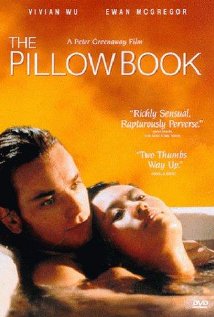
THE PILLOW BOOK
UK/Netherlands/Luxembourg, 1996, 126 minutes, colour.
Vivian Wu, Yoshi Oida, Ken Ogata, Ewan Mc Gregor.
Directed by Peter Greenaway.
Peter Greenaway’s films are unique. Trained as an artist, his films look like paintings. But he belongs to the lavish school, almost crowding many scenes with as much visual detail as possible. He also loves music and incorporates it always as a significant part of his films.
This film has a Japanese origin, and uses a Japanese filming style, sometimes in black and white, to introduce the central character, a young girl who grows up to be a provocative woman. As a child, an artist exercises his calligraphy on her body. The scene recurs throughout the film. When she is an adult and has moved to Hong Kong, the woman is interested in calligraphy, in storytelling, in using calligraphy to write the stories on the bodies of men with whom she has a sexual relationship.
The most significant of these is the young British translator in Hong Kong, played by Ewan Mc Gregor, who is in a sexual relationship with a publisher. He allows his body to be written on, takes himself to reveal the book on his body to the publisher. There is resistance and the woman tries writing on many men, with many relationships, in order for her book to be published.
In the first half of the film, the visual sequences are numbered and listed from an original book. In the latter part of the film, there are 14 books, Pillow Books, which recount the experiences of the young woman, her relationships.
Many audiences will find the film rather esoteric – and it is in many ways. But it is characteristic Greenaway and those who admire his films will be more than satisfied.
1. The films of Peter Greenaway? His interest in art, calligraphy, music and pageantry? The role of film and incorporating these elements? The development of Greenaway’s career?
2. Themes of life, science, publishing, writing, sexuality? The characters? Asia and Europe?
3. The impact of the visuals, sets, decor, costumes, design?
4. The kinds of music, East, West?
5. The recurring images, the girl child, writing, the artist, calligraphy, the story, the destiny? The sequence repeated throughout the film like a chorus?
6. The range of quotations, the numbers, the visuals? Life and sex?
7. Nagika, little girl, the painting, the body, her sensuousness, sensuality, the various versions? As an adult? The desire to publish? The refusals? The range of characters, the quality of their skin, their bodies, methods of writing? Texture? Clarity of calligraphy? Blurring?
8. Sexuality, traditions, magic, experiences, writing of the books?
9. Jerome, the translator, his work, from Britain? In Hong Kong? The sexual relationship with the publisher, his influence? His permitting Nagika to write on him, the effect, their sexual encounters, going to the publisher?
10. The range of versions, the range of men, the style of writing, the sexual experiences? The men going to the publisher, delivering the manuscript on themselves, pillow book?
11. The title of the film, the number of books, the headings?
12. Jeromr, the books, his work, his mother and sister talking about him, his mother’s reflections on his life, sexuality, with the publisher, with Nagika? His death? The funeral?
13. The other men, the range men, the variety of appearances, tall, short, thin, fat? The appearances of the men, their experiences, nudity and sexual, and the calligraphy on their bodies?
14. Naked and choices, experiences?
15. The Japanese background, Hong Kong and its modern style? Permissive? The effect of all these experiences on Nagika?
16. The audience sharing them – or observing them?